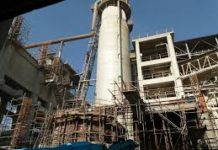By Muhammad Luqman
Pakistan has successfully diversified its gas import sources as first liquefied natural gas (LNG) vessel with the arrival of first vessel from Nigeria carrying 70,000 ton at the Floating Storage and Re-gasification Unit at Port Qasim near Karachi.
Before the fresh supplies, Pakistan has been importing LNG from Qatar since March 2015. The government is also negotiating a state-to-state LNG deal with the Western African country.
Global commodity trader Gunvor, headquartered in Switzerland, brought the LNG cargo from Nigeria through Golar Kevin vessel at the second LNG terminal, which was inaugurated by Prime Minister Shahid Khaqan Abbasi on November 20.
With the arrival of the first cargo at the new terminal, acceptance tests will be undertaken immediately and after their completion, LNG supply to the national grid will rise by 600 million cubic feet per day (mmcfd) in the next few days.
Already, the first LNG terminal at Port Qasim has been handling and processing 600 mmcfd of gas.
Pakistan has achieved a milestone as higher LNG imports will ensure that gas load-shedding virtually comes to an end in the current winter, according to government officials.
Three LNG-based power plants with cumulative production capacity of 3,600 megawatts are being set up in central Pakistan province of Punjab, which will need uninterrupted supply of gas. They will receive the imported gas processed at the second LNG terminal.
Owing to the fast widening gap between demand and supply of energy in Pakistan, the government has been pursuing LNG imports for the past around three years.
With the opening of new terminal, the total LNG imports have touched the mark of 1.2 billion cubic feet per day that would be consumed by power plants, fertiliser and cement plants, general industry and compressed natural gas (CNG) filling stations especially in Punjab province that produces only 5 percent of country’s total gas.
The second LNG terminal, with the same 600mmcfd handling capacity, has been developed by Pakistan GasPort Limited with an investment of $500 million. The company has planned to build one more LNG terminal with a similar $500-million investment.
Two more LNG terminals are also planned to be built at Port Qasim which are expected to be commissioned in the second and third quarters of 2018.















